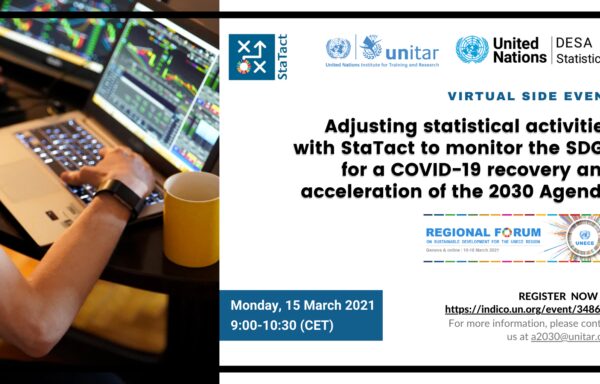
On March 15, 2021, UNITAR and UN Statistics Division conducted a side event – “Adjusting statistical activities with StaTact to monitor the SDGs for a COVID-19 recovery and acceleration of the 2030 Agenda” – as part of the UNECE Regional Forum 2021. Attended by over 50 participants, the side event consisted of three segments – first, an introduction of the platform and its principles: second, a demonstration of StaTact, and third, sharing of a practical country experience where StaTact has been utilized.
The webinar began with Ms. Elena Proden, Senior Specialist, Strategic Implementation of the 2030 Agenda Unit at UNITAR introducing the StaTact programme and the objectives of the side event. StaTact, being an action-oriented tool, is also consultative and collaborative, and is not only useful for long-term planning but also for short-term and experimental statistics projects. Further, Ms. Proden focused on how StaTact can be used to monitor progress on SDG implementation, and the centrality of statistical activities for the same.
Explaining the fundamental principles of the models, Mr. Gabriel Gamez, Inter-Regional Advisor, UN Statistics Division began with a simple analogy – “You have planned a very long journey... You have a map ready which road you are going to take so you know where you will be... where you want to arrive, once everybody is jumping into the car suddenly the car does not start. So you have a beautiful strategy, a beautiful map, you have taken all the picnics that you need, you have enough fuel etc. But you have something that cannot start. StaTact is exactly the tool that will help you to fix your engine again so that your car will start.”
Mr. Gamez explained that 90% of the data today has been created during the last 2 years; amid this data frenzy, it is essential to convert data into knowledge. Given this need, StaTact is developed based on two models – GSBPM Generic Statistical Business Process Model (production) and GAMSO Generic Activity Model for Statistical Organizations (governance) – elaborated upon in the presentation. The second segment was concluded by Mr. Trevor Fletcher, Consultant, UNITAR with presentations of various problem statements and analyses, and the detailed demonstration of the StaTact tool for problem-solving, action planning, and project management to address SDG data gaps.
Ms. Minerva Eloisa P. Esquivias, Deputy National Statistician, Philippine Statistics Authority conducted the final segment (prior to the Q&A section) and highlighted the experience of using StaTact at the country level in The Philippines. She mentioned it was overall a positive experience and aided the organizational tasks and monitoring processes, and also successfully used it to build collaborations and private partnerships.
The Webinar concluded with a round of questions from the audience members, who largely appreciated the platform and raised concerns about the engagement of civil society in the use of StaTact, access to recourses from national statistical offices, the use of the tool for COVID-19, and indicators that could be used for monitoring the situation.
For more information about StaTact, please contact a2030@unitar.org.
